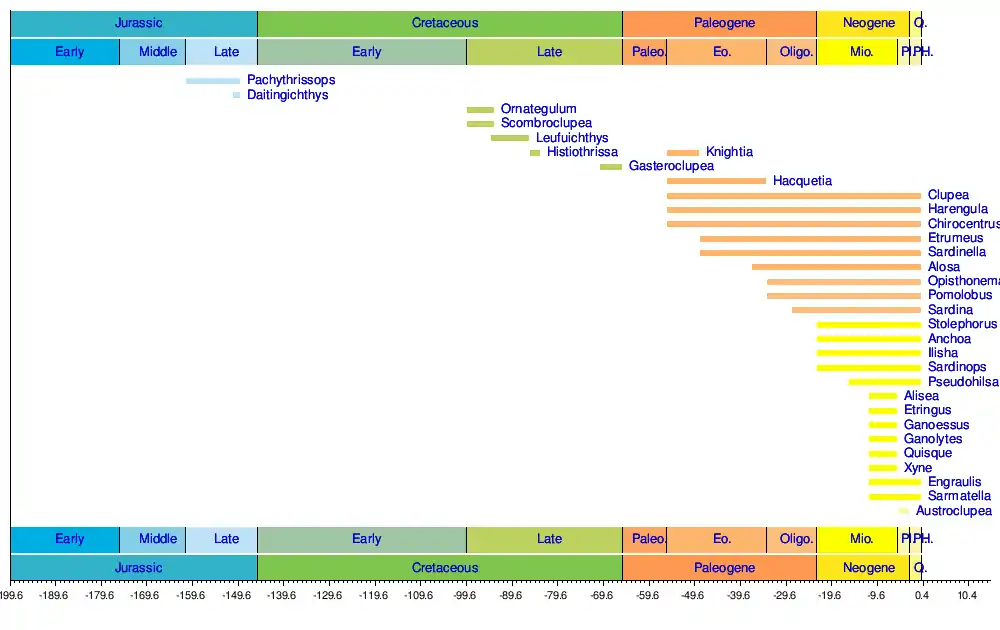Clupeiformes
Clupeiformes /ˈkluːpiːɪfɔːrmiːz/ is the order of ray-finned fish that includes the herring family, Clupeidae, and the anchovy family, Engraulidae. The group includes many of the most important forage and food fish.
| Clupeiformes Temporal range: Late Jurassic to present | |
|---|---|
 | |
| Atlantic herring, Clupea harengus | |
| Scientific classification | |
| Kingdom: | Animalia |
| Phylum: | Chordata |
| Class: | Actinopterygii |
| (unranked): | Otocephala |
| Superorder: | Clupeomorpha |
| Order: | Clupeiformes Goodrich, 1909 |
| Type species | |
| Clupea harengus | |
| Families | |
|
See text | |
Clupeiformes are physostomes, which means that their gas bladder has a pneumatic duct connecting it to the gut. They typically lack a lateral line, but still have the eyes, fins and scales that are common to most fish, though not all fish have these attributes. They are generally silvery fish with streamlined, spindle-shaped, bodies, and they often school. Most species eat plankton which they filter from the water with their gill rakers.[1]
The former order of Isospondyli was subsumed mostly by Clupeiformes,[2] but some isospondylous fishes (isospondyls) were assigned to Osteoglossiformes, Salmoniformes, Cetomimiformes, etc.[3]
Families
| Phylogeny of Clupeiformes by Lavoué et al 2014.[4] | ||||||||||||||||||||||||||||||||||||||||||||||||||||||||||||||||||
|
The order includes about 405 species in seven families:[5][6]
- Order Clupeiformes
- Suborder Denticipitoidei
- Family Denticipitidae (denticle herring)
- Suborder Clupeoidei
- Family Engraulidae (anchovies)
- Subfamily Coiliinae
- Subfamily Engraulinae
- Family Spratelloididae
- Family Pristigasteridae (longfin herrings)
- Subfamily Pristigasterinae
- Subfamily Pelloninae
- Family Chirocentridae (wolf herrings)
- Family Dussumieriidae s.s. (round herrings)
- Family Clupeidae [incl. Sundasalangidae) (herrings, sardines, shads, and menhadens)
- Family Engraulidae (anchovies)
- Suborder Denticipitoidei
Timeline of genera

References
- Nelson, Gareth (1998). Paxton, J.R.; Eschmeyer, W.N. (eds.). Encyclopedia of Fishes. San Diego: Academic Press. pp. 91–95. ISBN 0-12-547665-5.
- Journal of Ichthyology. 46. Scripta. 2006. p. S40.
within Isospondyli (= Clupeiformes s. lato)
- lfonso L. Rojo (2017). Dictionary of Evolutionary Fish Osteology. CRC. p. 170. ISBN 978-1-351-36604-5.
Under the name Isospondyli, Regan (1909) grouped the fishes having the verterbrae immediately after the skull similar in shape to the remaining ones, in contrast to the ostariophysans, in which the anterior vertebrae are greatly modified. Modern classifications have rejected this artificially constructed group, and the fishes previously assigned to it have been distributed among different orders (Clupeiformes, Osteoglossiformes, Salmoniformes, Cetomimiformes, etc.)
- Sébastien Lavoué, Peter Konstantinidis & Wei-Jen Chen: Progress in Clupeiform Systematics. in Konstantinos Ganias (Hrsg.): Biology and Ecology of Sardines and Anchovies. CRC Press, 2014, ISBN 978-1482228540
- Froese, Rainer, and Daniel Pauly, eds. (2012). "Clupeiformes" in FishBase. August 2012 version.
- Lavoue ´ S; Miya M; Musikasinthorn P; Chen W-J; Nishida M (2013). "Mitogenomic Evidence for an Indo-West Pacific Origin of the Clupeoidei (Teleostei: Clupeiformes)". PLoS ONE. 8 (2): e56485. Bibcode:2013PLoSO...856485L. doi:10.1371/journal.pone.0056485. PMC 3576394. PMID 23431379.
- Sepkoski, Jack (2002). "A compendium of fossil marine animal genera". Bulletins of American Paleontology. 363: 1–560. Archived from the original on 2009-02-20. Retrieved 2011-05-17.
